If you’re a big fan of snakes, you might be surprised to hear that there are a few semi-aquatic and terrestrial snakes that live in or around the Willamette River in Oregon. It certainly makes sense, considering how massive this famous American river is!
Let’s break down some information about the Willamette River. Then we’ll dive into the five most common snakes found in the area.
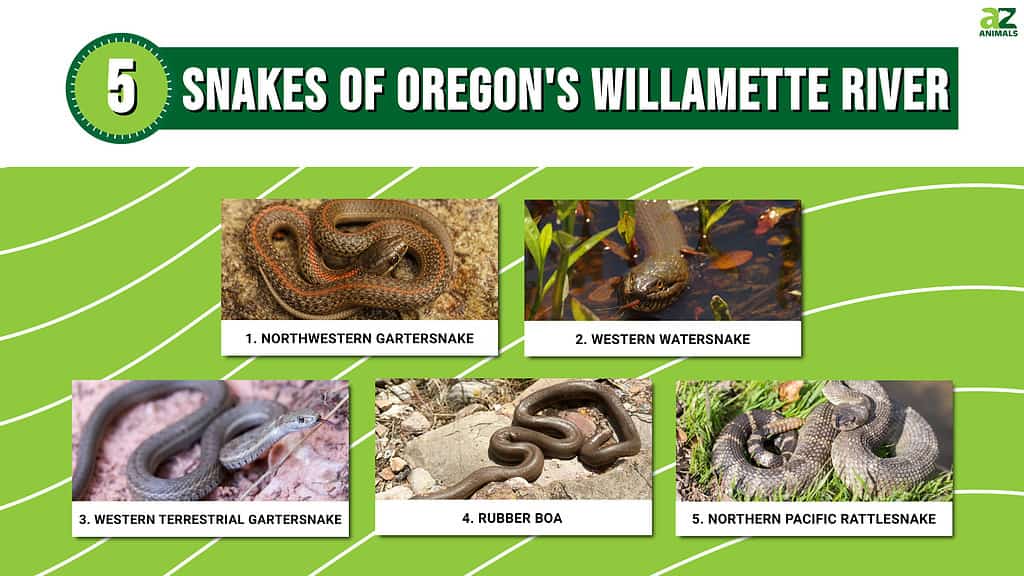
©
Where is the Willamette River?
In the Pacific Northwest area of the United States, through the state of Oregon runs the prominent Willamette River. The Willamette River flows through Oregon for almost 300 miles from its source in the Cascade Mountains to where it meets the Columbia River. It is an essential component of the state’s landscape and has a significant impact on the area’s environment, economics, and recreational possibilities.
The river is extremely significant ecologically since it supports a variety of ecosystems and a wide variety of fauna. Salmon, steelhead, trout, sturgeon, and other fish species abound in its waterways. These fish attract fishermen from near and far and are useful for both commercial and leisure fishing. A refuge for birdwatchers and environment lovers, the river’s riparian sections are home to many bird species, including bald eagles, ospreys, herons, and ducks. And, of course, some snakes as well!
The Willamette River has been essential to Oregon’s history and development in addition to its ecological importance. The area along the river has been home to Native American tribes for thousands of years, and it continues to be significant to these groups both historically and culturally. In the middle of the 19th century, villages and cities were founded along its banks by European-American settlers, which later developed into the prosperous Willamette Valley. The river functioned as a channel for commerce and trade, promoting the development of sectors including agriculture, logging, and industry.
The Willamette River Today

The Willamette River continues to be a beloved recreational asset for locals and tourists alike today. Its waters are accessible through a number of parks, marinas, and boat ramps. It provides chances for boating, kayaking, paddle boarding, and swimming. The river is a well-liked location for outdoor leisure and a break from city life due to its visual appeal and accessibility to metropolitan regions.
The Willamette River is currently being protected and restored. To maintain its long-term survival and the maintenance of its biological integrity, different programs are being implemented. Water quality improvement projects, habitat restoration initiatives, and conservation programs are just a few initiatives that are being implemented.
With this in mind, let’s check out some snakes that live in the Willamette River!
1. Northwestern Garter Snake
Classification: Thamnophis ordinoides
The Willamette River area of Oregon is home to a non-venomous snake species known as the Northwestern garter snake. With a length range of 18 to 45 inches, it is a rather slim snake. The hue of the Northwestern gartersnake varies considerably, although it normally has a black background and three longitudinal stripes of yellow or greenish-yellow tint.
The Northwestern gartersnake is harmless to humans, in contrast to several deadly snake species in Oregon. Instead of using venom, it uses its swift movements and musk emission as a defensive strategy.
The warmer months, usually from spring through autumn when the weather is more hospitable, are when these snakes are most active. They are diurnal, which means they spend most of their time active during the day. Though in warmer temperatures, they could become more crepuscular or active at dawn and twilight.
Northwestern garter snakes inhabit a variety of habitats along the Willamette River’s bank, including marshes, wetlands, and riparian regions. Due to their ability to swim, they are semi-aquatic and frequently seen close to water sources, including the river itself. These snakes graze on a range of food, including tiny fish, amphibians, invertebrates, and even small animals. They are considered opportunistic feeders.
Although the Northwestern gartersnake is typically non-aggressive and harmless, it is nevertheless suggested to keep a safe distance and avoid handling them in order to save the snake any additional stress or injury.
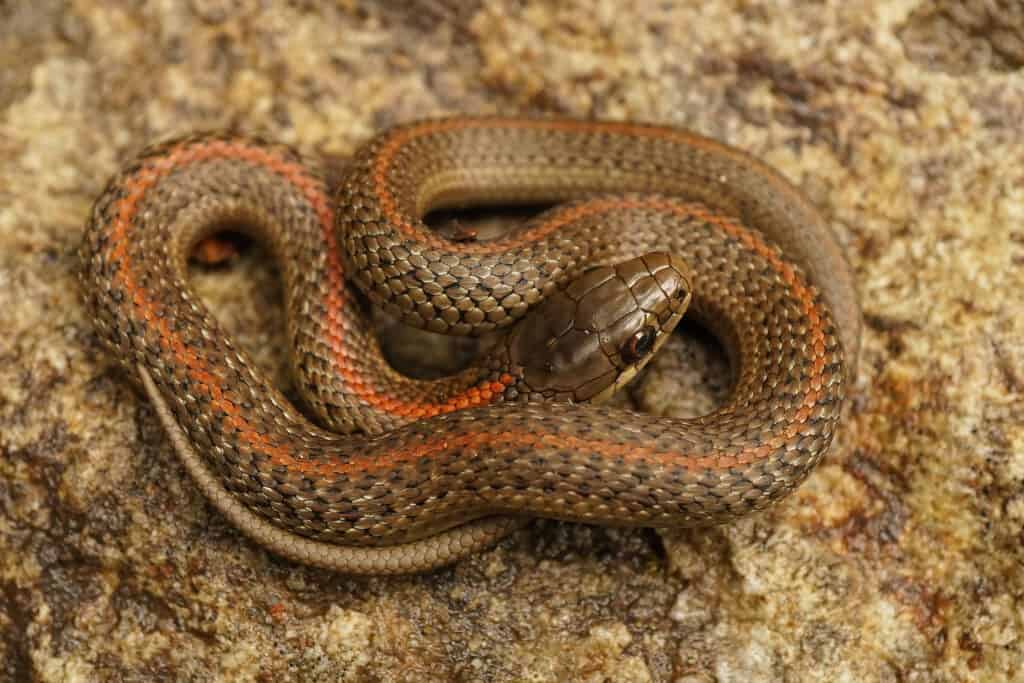
The Northwestern gartersnake (pictured) is usually very non-aggressive and safe to be around humans.
©HWall/Shutterstock.com
2. Western Watersnake
Classification: Nerodia sipedon
The Willamette River and its nearby areas are home to a non-venomous snake species known as the Western (or sometimes Northern) watersnake. It is two to four feet long and is considered a rather strong snake. Its varying coloration usually consists of dark brown or gray with dark spots or bands along its body.
The Western watersnake lacks venom glands and fangs, making it another relatively harmless snake found in the Willamette River. It constricts and swallows its victims, which are primarily fish and amphibians.
Diurnal in nature, Western watersnakes are most active during the day. They can swim well and may be seen in and out of the water. However, they are frequently seen lounging on rocks or plants close to the water.
Western watersnakes live in a variety of aquatic environments in the Willamette River, including still or slowly-flowing water bodies like the river itself, ponds, lakes, marshes, and other wetland regions. They have a wide range of environmental preferences since they can survive in both freshwater and brackish water habitats. This is pretty rare for a snake!
Western watersnakes are typically not hostile toward people. If threatened or cornered, though, they could become defensive and bite. It is best to keep your distance and refrain from touching them in the wild.
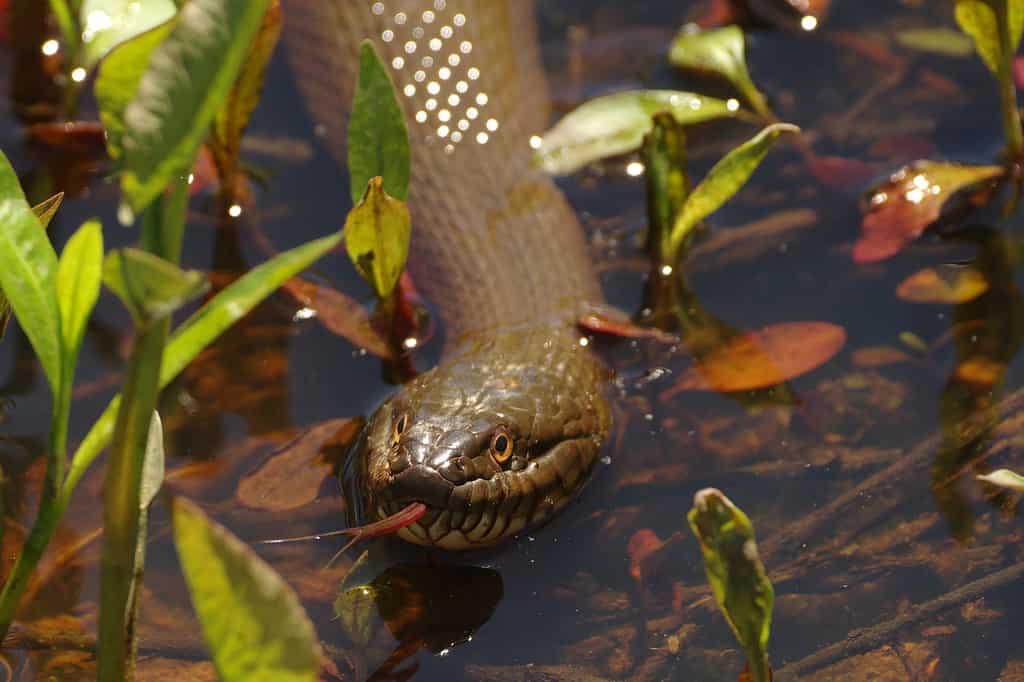
The Western watersnake (pictured) spends much of its time in the water.
©Philip Yabut/Shutterstock.com
3. Western Terrestrial Garter Snake
Classification: Thamnophis elegans
The Willamette River basin and adjacent areas of the western United States are home to the non-venomous Western terrestrial gartersnake. This is a slim snake that ranges in length from 18 to 42 inches and has a wide range of colors. While some individuals may have more subdued tones, others may have a black or dark brown base hue with yellow, orange, or reddish stripes.
The Western terrestrial gartersnake is non-venomous and does not represent a threat to people, like the majority of gartersnake species. It seizes and eats its prey whole, which includes small mammals, amphibians, and invertebrates.
Diurnal in nature, Western terrestrial garter snakes are most active during the day. They frequently appear in a variety of terrestrial environments, including grasslands, meadows, forests, and marshes, either sunbathing or hunting for food.
Despite not being an aquatic species, the Western terrestrial gartersnake can be found close to water sources like the Willamette River. They can live close to the river, perhaps in the neighboring marshes, streams, or ponds. These watery habitats are essential to them for drinking, hunting, and finding compatible mates.
Western terrestrial garter snakes are normally docile. But if they feel threatened or touched, they may attempt to bite or exude a foul-smelling musk. That musk is not something you want to deal with! It’s best to maintain a safe distance.
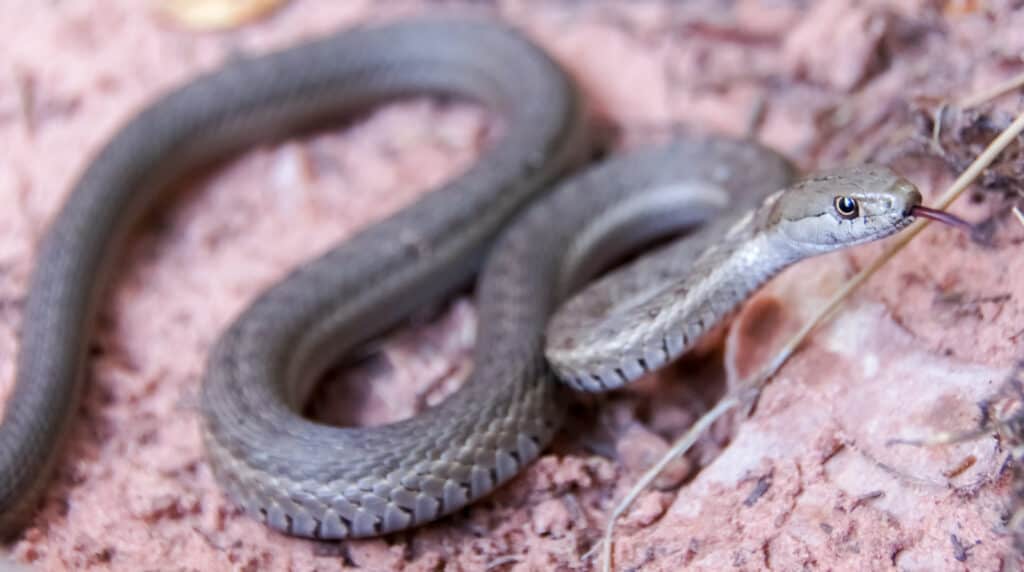
Western terrestrial garter snakes (pictured) are capable of musking a foul-smelling odor.
©iStock.com/yhelfman
4. Rubber Boa
Classification: Charina bottae
The Willamette River basin and adjacent areas of the western United States are home to the unusual and interesting rubber boa snake species. It is a small to medium-sized snake with a typical length of 15 to 33 inches. The term “rubber boa” refers to the snake’s skin’s smooth, rubbery feel and appearance.
The rubber boa is not venomous and doesn’t represent a hazard to people, in contrast to many other snake species. It uses constriction to trap and eat tiny mammals, reptiles, and amphibians rather than venom to sedate its prey.
Because they are generally nocturnal, rubber boas are most active at night. They are nocturnal hunters who frequently spend the day hiding beneath rocks, logs, or in burrows before emerging at dusk or at night to look for food.
Despite not being a purely aquatic species, the rubber boa occasionally inhabits riparian areas close to the Willamette River. They could make use of the locations close to the river, especially those with thick foliage and good hiding places. However, highland ecosystems like woods, grasslands, and shrublands are where you may find them more frequently.
The placid and gentle temperament of rubber boas is what makes them popular as exotic pets. They can coil their bodies and conceal their heads behind their coils in order to defend themselves when threatened. As with any experience with wildlife, it is crucial to be respectful and careful with these snakes. Do not take any wild animal home with you to keep as a pet!
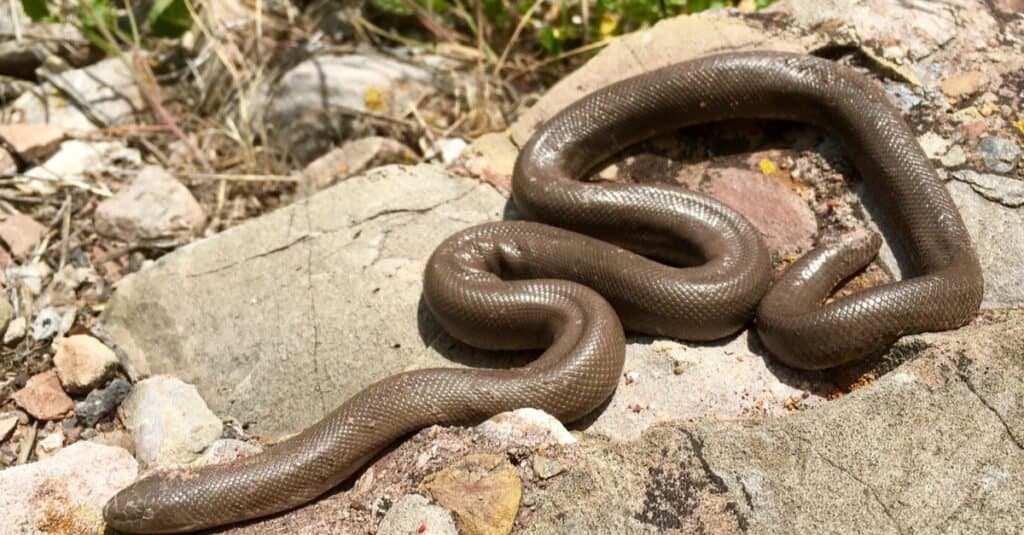
The rubber boa (pictured) gets its name from its rubbery skin.
©Matt Jeppson/Shutterstock.com
5. Northern Pacific Rattlesnake
Classification: Crotalus oreganus
The Willamette River basin and other locations in the western United States are home to the venomous Northern Pacific rattlesnake. This species is a pit viper that is recognizable by the way it rattles its tail when it feels threatened. The Western rattlesnake has a number of subspecies, each with a somewhat different appearance and preferred environment.
The venom of the Northern Pacific rattlesnake is used to paralyze its victims, which are mostly small animals. Despite being venomous, it normally avoids conflict with people and will flee if given the chance. If you run into this snake, it’s important to take precautions and give it plenty of space. It is best to keep a safe distance and avoid any encounters if you come across a Northern Pacific rattlesnake.
These rattlesnakes are mostly nocturnal and most active in the summer when the weather is hospitable. They may be found in a range of environments, including grasslands, woods, rocky outcrops, and even close to water sources like the Willamette River. These Rattlesnakes are more frequently observed in the eastern, drier regions of Oregon than they are along the river in the Willamette River basin.
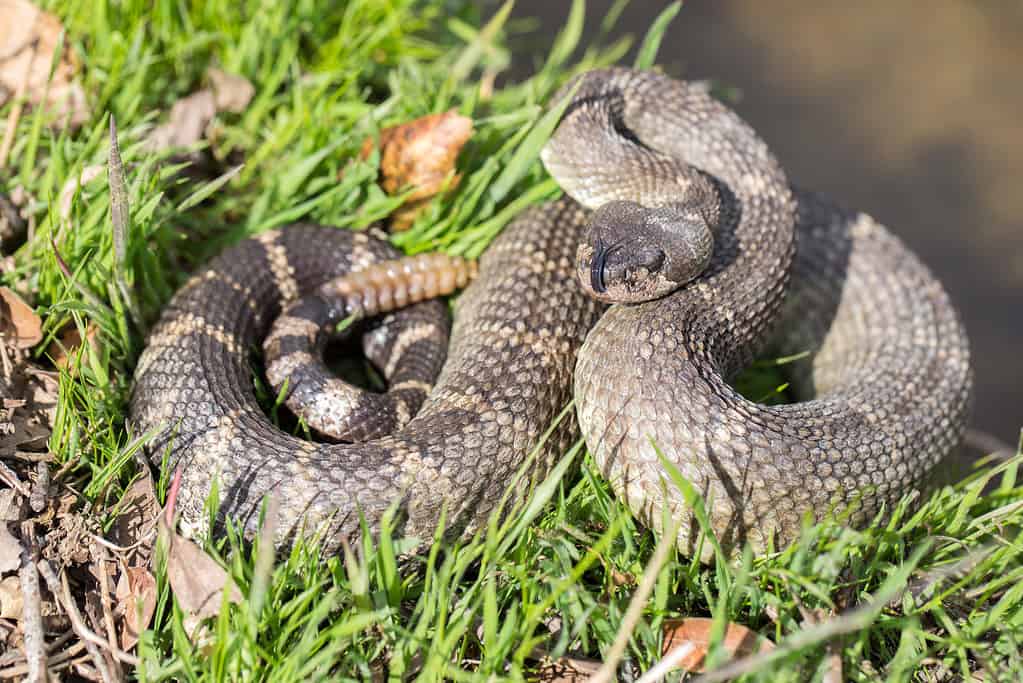
Northern Pacific rattlesnakes (pictured) are potentially deadly.
©iStock.com/yhelfman
Other Animals That Live in or Near the Willamette River
Numerous aquatic and terrestrial species of animals may be found in the Willamette River and its surrounding habitats. There are several remarkable creatures that make the Willamette River home outside of snakes, including fish, mammals, and birds.
Fish
Salmon and steelhead runs are well-known for occurring in the Willamette River. Chinook, coho, and steelhead fish make extraordinary journeys from the ocean to the freshwater tributaries of the river in order to spawn. These recognizable fish are an essential resource for both commercial and recreational fishing and perform a critical ecological function.
Turtles
A species of freshwater turtle called the Western pond turtle can be found along the Willamette River. They live in still or slowly flowing bodies of water, such as ponds and lakes in oxbow rivers. Due to habitat degradation and fragmentation, these turtles are regarded as a species of concern.
Another type of freshwater turtle that may be found along the Willamette River is the Western painted turtle. They live in a range of aquatic environments, such as marshes, rivers that move slowly, and ponds. Western-painted turtles are frequently spotted sunbathing on logs or rocks. They are distinguished by their colorful shell patterns and red or orange markings on their undersides.
River Otters
Semi-aquatic mammals called river otters live in and around the Willamette River. They are adept swimmers and are frequently seen playing along the riverbanks or gliding through the water. River otters are well-known for their playful personality and eat fish, amphibians, and invertebrates throughout the river.
Bald Eagles
The magnificent bald eagle can frequently be seen near the Willamette River. These symbols of America have their nests in large trees close to the river, and their main food source is fish. Spotting a bald eagle soaring over the river is an amazing experience. Their highly distinguishable white heads and enormous wingspans make them immediately identifiable.
Blue Great Herons
The Willamette River offers the great blue heron the perfect environment. Along the riverbanks, one may see these enormous wading birds holding still and waiting for fish and other small water prey to pass by. They are a stunning sight because of their remarkable size, long necks, and gray-blue plumage.
These are just a few examples of the varied species that inhabit the Willamette River and its surrounding areas. Numerous creatures are supported by the region’s diverse ecosystems and rich ecosystems, which add to the region’s overall biodiversity and natural beauty.
Is the Willamette River Safe to Swim in?
Before swimming in the Willamette River, it’s vital to take into account variables, including water quality and safety procedures. Keep the following in mind before you go swimming in the Willamette River:
- Like many rivers, the Willamette River can have variable water quality based on elements such as upstream pollutants, climate, and urban runoff. Although there have been considerable recent attempts to enhance the river’s water quality, it is nevertheless important to verify the most recent water quality reports or advisories issued by regional authorities or health departments before swimming.
- This is a sizable body of water with shifting currents and possible dangers. It’s critical to be knowledgeable about the river’s hazards, including water flow, temperature, and any unique safety issues. Pay close attention to any cautions or suggestions made by local authorities regarding swimming or other leisure activities.
- Always follow the required safety precautions if swimming in the Willamette River is declared safe and authorized. Always stay in specified swimming areas, refrain from diving into uncharted waters, and take extra care around submerged objects, strong currents, and drop-offs. Additionally, it’s a good idea to swim with a friend and make sure you can swim well.
- It is advised to refrain from eating or consuming the water in any natural body of water, including the Willamette River. Additionally, those with specific medical issues or immune systems that are weakened may be more vulnerable to contracting waterborne diseases, so it is best to speak with a healthcare provider if you have any concerns.
Always Play It Safe
Since local authorities are most qualified to judge the present safety and water quality conditions of the Willamette River, it is essential to keep informed and heed the advice given by them. The most recent information about swimming safety and any relevant warnings may be found by contacting municipal authorities, health departments, or park services.
Summary of 5 Snakes of Oregon’s Willamette River
| Number | Snake |
|---|---|
| 1 | Northwestern Garter Snake |
| 2 | Western Watersnake |
| 3 | Western Terrestrial Garter Snake |
| 4 | Rubber Boa |
| 5 | Northern Pacific Rattlesnake |
The photo featured at the top of this post is © Clement Horvath/Shutterstock.com
Discover the "Monster" Snake 5X Bigger than an Anaconda
Every day A-Z Animals sends out some of the most incredible facts in the world from our free newsletter. Want to discover the 10 most beautiful snakes in the world, a "snake island" where you're never more than 3 feet from danger, or a "monster" snake 5X larger than an anaconda? Then sign up right now and you'll start receiving our daily newsletter absolutely free.
Thank you for reading! Have some feedback for us? Contact the AZ Animals editorial team.






